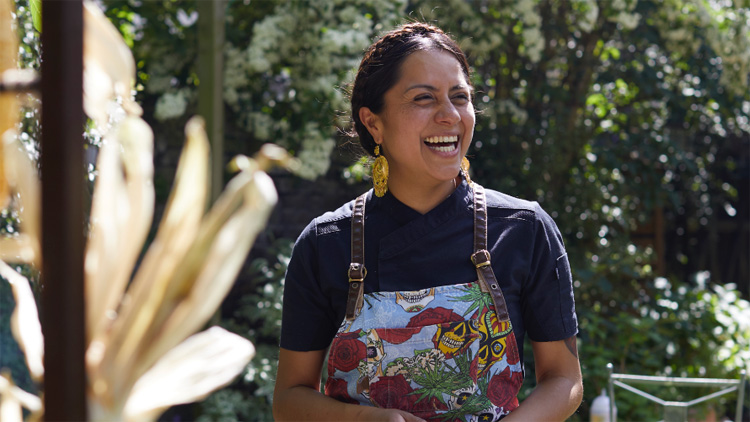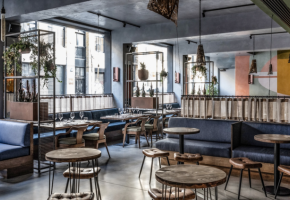On a crisp Friday morning, I met the Mexico City-born chef Adriana Cavita and her sous-chef Ernesto Puga from Veracruz, Mexico, outside of her Marylebone restaurant. Indeed, on the inside, the space looks very cave-like, with plenty of exposed brick and an underground cellar mezcal bar that will have a separate entrance to the main dining space.
Construction workers were busy drilling and climbing ladders, installing what promises to be a state-of-the art kitchen, where the focal point will be the charcoal grill. Cooking with wood, a las brasas, with the earth itself, is key to capturing the essence of Mexican flavours, Adriana told me.
Mexico is fiercely underrepresented in London’s immense culinary scene. Nonetheless, there has been some progress of late, with several exciting taquerías popping up across the capital. In 2017, we saw El Pastor open in Borough Market, where they do seriously good carnitas and al pastor tacos, not to mention their soupy frijoles charros, topped with crunchy chicharrón (pork crackling). Meanwhile, at the Tigre Tacos truck in Bermondsey, they are plating up some truly mouth-watering Baja fish and prawn tacos.
Though tacos –in some shape or form– promise to feature on the menu at Cavita, Adriana’s vision is a little broader in scope.
“People think Mexican food is unhealthy,” laments Adriana. “So, I’m trying to change that perception. Everyone says, it’s a lot of meat, no? It’s very greasy. And I’m like, no. It’s about education, I suppose. More people have been to Mexico over the last few years, and they are realising how diverse Mexican gastronomy can be.

Traditional Mexican flavours and cooking techniques will be transported and transposed across the Atlantic. The literal seeds, las semillas, will be taken from Mexico and recomposed on a plate in London. Even the cinnamon must be Mexican, Adriana insists.
“Mexican cinnamon does not the same taste as cinnamon from the other side of the world. And I think it’s really important to reproduce the flavours from Mexico. So that’s why I put so much emphasis on bringing over Mexican ingredients.”
The way that Adriana speaks about food is deeply connected with the earth. She expresses a duty of care for living things. Her grandfather was a farmer, he grew corn and cooked rabbit frequently. To this day, Adriana retains the tactile memory of the animals and plants that surrounded her as a child.
It was Adriana’s grandmother who first brought her into the kitchen. She had a small business in Mexico City, selling antojitos mexicanos to the neighbours. Adriana recalls playing with her abuela’s masa: “It was my Play-Doh. In Mexico, you don’t get that kind of stuff at that age. So, she gave me the masa, and I used to make little things, and she would cook them for me. Gorditas, or little huaraches. She’d put them on the comal, and then I’d eat them. That’s how you learn when you’re a child. Playing and making.”
History and heritage is integral to cuisine in Mexico. Many of Adriana’s dishes use ancestral cooking techniques, like the use of leaves and cooking in the ground.
“It’s important to learn from the past, to understand how food evolved, so you can really create flavours for the future, to have your own views,” explains Adriana. “If you don’t know how your ancestors used to cook, then how are you supposed to have that connection with what you’re doing. That’s how I connect with Mexican food. By understanding the ingredients and where they come from."

Discouraged from pursuing a career as an artist by her mother, Adriana studied gastronomy at university. She knew that she wanted to do something where she could use her hands, and she excelled in her classes. Cookery was taught from the chemical level. There were modules in culinary history, chocolate work, French cuisine, mixology, the list goes on.
While still a student, Adriana won a cooking contest which sent her to Roses, Spain, to train at the then-best restaurant in the world, El Bulli. Later, she would go on to work at Pujol in Mexico City, under the wing of the visionary celebrity chef Enrique Olvera. Fast-forward a few years, and now Adriana is set to open her very first restaurant, in London of all places.
“I lived in New York for a year, and I came back to Mexico to do some research. Then after a year or two in Mexico, I wanted to do something else. I had an opportunity to go back to New York, but at the same time Eduardo García [a former Pujol chef] asked me, ‘Why don’t you come to London? I want you to work with me.’ I wanted to come back to Europe. I felt more connected with Europe than the US. London felt more diverse. I felt like I had something to learn. I arrived in London three weeks before Peyotito opened and after three years, the restaurant closed permanently.
One of the joys of living in Mexico is being able to go to the market and eat incredibly fresh and delicious food at a reasonable price and, as we know London prices aren’t reasonable.
“I’m trying to do a lunch menu. I’m not sure how often or how exactly it would work. In Mexico you can sell anything, and the people are very open. I’m thinking of offering a vegan option and a seafood/meat option, in the same format as in Mexico, where you get a soup, a main dish, and an agua de sabor. One of my ideas is to have more options for non-alcoholic drinks, which is how it would be in Mexico, no? It’s healthier as well.”
Cavita and its accompanying mezcal bar Mayahuel (named after the goddess of the maguey plant) are due to open in London’s Marylebone this spring.


















